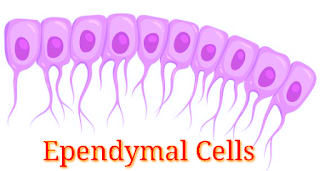HUMAN BRAIN
Brain is a organ of soft nervous tissue contained in the skull of vertebrates, functioning as the coordinating centre of the body.
PARTS OF BRAIN
Human brain is divided into three major parts on the basis of their functions and placement :-
1. Fore Brain
2. Mid Brain
3. Hind Brain
 |
| DIAGRAM OF HUMAN BRAIN |
1. FORE BRAIN :- It is the anterior part of the brain
It has three parts :-
- Thalamus
- Limbic System
- Cerebrum
THALAMUS :- it is located above the brain stem and between the cerebral and Mid-Brain.
FUNCTION :- It carries sensory information from the body to cerebrum and the limbic system.
HYPOTHALAMUS :- It lies under the thalamus.
FUNCTION :- It connects the nervous system with the endocrine system via pituitary gland.
LIMBIC SYSTEM :- It is arc shaped structure between thalamus and cerebrum.
FUNCTION :- It controls responses like :-
- Hunger
- Fear
- Thirst
- Anger
- Sexual responses etc.
CEREBRUM :- It is divided into two halves called cerebral hemisphere.
- They communicate via Corpus Callosum. (Represent white matter)
- Cerebral Cortex ( Represent gray matter) is the outer region of cerebrum.
FUNCTION :- - It helps in movement
- It controls speech.
- It is responsible for sensory processing.
- It determines the intelligence of the being.
2. MID-BRAIN :- It is located below the cerebral cortex and above the hind brain.
FUNCTION :- It controls reflex movements of the body and hearing reflexes.
3. HIND BRAIN :- It is present at the backside of the brain.
PARTS :- It consist of :-
- Cerebellum
- Pons
- Medulla Oblongata
CEREBELLUM :-
Meaning :- It is latin term for little brain
Position :- It is located at the back side of the head.
function :- It controls the balance of the body and co-ordinates the voluntary movement of the body.
PONS :-
Meaning :- Pons mean - "Bridge"
Position :- It is located above medulla Oblongata.
Function :- It controls sleep as well as rate and pattern of breathing.
MEDULLA OBLONGATA :- It is the posterior part of the brain.
FUNCTION :- It controls automatic actions example :- Breathing, Heart Rate, Swallowing, Circulation etc
BRAIN LOBES
Brain is divided into four lobes :-
- Frontal Lobe
- Parietal Love
- Occipital Lobe
- Temporal Lobe
 |
| BRAIN LOBES DIAGRAM |
CRANIAL NERVES
There are 12 pairs of cranial nerves originating from the nuclei in the inferior surface of brain.
Some are sensory, some are motor and some are mixed.
 |
| 12 Pairs of Cranial Nerves |
 |
| Diagram of Cranial Nerves |
NEURONS
NEURONS :- The neural System of all animals is composed of highly specialised cells called neurons.
FUNCTION :- Which can detect, receive and transmit different kinds of stimuli.
A Neuron is a microscopic structure composed of three major parts :-
1. Cell Body
2. Dendrites
3. Axon
CELL BODY :-
The cell body contains cytoplasm with typical cell organelles and certain granular bodies called Nissl's granules.
DENDRITES :-
Short branch repeatedly and project out of the cell body and also contain Nissl's granules and are called dendrites.
FUNCTION :- These fibres transmit nerve impulses towards the cell body.
AXON :-
It is a long fibre, the distal end of which is branched.
FUNCTION :- Axon transmit nerve impulses away from the cell body to a synapse or to a neuro-muscular junction.
SYNAPTIC KNOB :-
It is a bulb like-structure, possess synaptic vesicles containing chemicals called neurotransmitters.
 |
| Diagram of Neuron |
NOTE :- Based on the number of axon and dendrites, the Neurons are divided into four types :-
1. Multipolar
2. Bipolar
3. Unipolar
4. Pseudounipolar
MULTIPOLAR :- One axon and two or more dendrites, found in the cerebral cortex.
BIPOLAR :- One axon and one dendrites, found in the retina of eye.
UNIPOLAR :- Cell body with one axon only found usually in embryonic stage.
PSEUDOUNIPOLAR :- It is a sensory Neurons, which contain one axon and split into two parts, which one go into periferal and other one into spinal cord.
NOTE :- There are two types of Axon
1. Myelinated
2. Non-Myelinated
MYELINATED AXON :- Myelinated nerve fibres are enveloped with Schwann cells.
which form a myelin sheath around the axon.
found in spinal and cranial nerves.
NOTE :- The gapes between two adjacent myelin sheaths are called Nodes of Ranvier.
UNMYELINATED AXON :- Unmyelinated nerve fibre is enclosed by a Schwann cells that does not form a myelin sheath around the axon.
found in autonomous and the somatic neural System.
 |
| Structure of Myelinated Axon and Non Myelinated Axon |
NEUROGLIA ( NEUROGLIA CELLS )
Glial cells, sometimes called neuroglia or simply glia are non-neuronal cells that maintain homeostasis, from myelin, and protect, support and protection for neurons.
TYPES OF NEUROGLIA CELLS
There are four types of neuroglia cells :-
1. Ependymal cells
2. Astrocytes
3. Microglial cells
4. Oligodendrocytes
EPENDYMAL CELLS (Light Pink)
Ependymal cells are ciliated-epithelial glial cells that develop from radial glia along the surface of the ventricles of the brain and the spinal canal.
FUNCTION:- Move cerebrous spinal fluid around to keep it homogeneous.
 |
| Structure of Ependymal cells |
ASTROCYTES (Green)
Astrocytes are specialized glial cells that outnumber neurons by over fivefold.
FUNCTION:- transport of blood-borne material to the neuron, and reaction to injury.
 |
| Structure of Astrocytes |
MICROGLIAL CELLS (Dark Red)
Microglia cells are the immune cells of the central nervous system.
FUNCTION :- They do phagocytosis to fight infection.
 |
Structure of Microglial cells
|
OLIGODENDROCYTES (Light Blue)
Oligodendrocytes are the myelinating cells of the central nervous system (CNS).
FUNCTION :- bind the CNS Neurons together and insulate the axons.
 |
| Structure of Oligodendrocytes |















